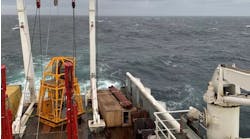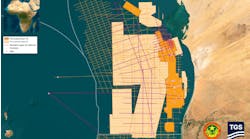BOEM issues ROD for environmental review of G&G survey activities off Atlantic Coast
Offshore staff
WASHINGTON, DC – After a transparent and robust public process, the US Bureau of Ocean Energy Management (BOEM) has issued a record of decision (ROD) establishing the highest practicable level of mitigation measures and safeguards to reduce or eliminate impacts to marine life while setting a path forward for appropriate geological and geophysical (G&G) survey activities off the Mid-Atlantic and South Atlantic coasts to update 40-year-old data on the region’s offshore resources.
The ROD does not authorize any G&G activities, but rather it establishes a framework for additional mandatory environmental reviews for site-specific actions and identifies broadly applicable measures governing any future G&G activities in the region. As new scientific information becomes available, these additional findings can be incorporated into the survey-specific environmental reviews through an adaptive management approach. BOEM will monitor implementation of these mitigations and, if warranted, will modify them as described in provisions of the Programmatic Environmental Impact Statement (PEIS) addressing “adaptive management.”
“After thoroughly reviewing the analysis, coordinating with federal agencies and considering extensive public input, the bureau has identified a path forward that addresses the need to update the nearly four-decade-old data in the region while protecting marine life and cultural sites,” says Acting BOEM Director Walter D. Cruickshank. “The bureau’s decision reflects a carefully analyzed and balanced approach that will allow us to increase our understanding of potential offshore resources while protecting the human, marine, and coastal environments.”
BOEM’s preferred alternative, which was presented in the PEIS released in February, includes the most protection for environmental and cultural resources of the alternatives considered consistent with moving forward with survey activity. Mitigation measures include vessel strike avoidance measures, special closure areas to protect the main migratory route for the highly endangered North Atlantic right whale, consideration of geographic separation of simultaneous seismic airgun surveys, and passive acoustic monitoring to supplement visual observers and improve detection of marine mammals prior to and during seismic surveys.
As a result of the selection, BOEM will consider permit applications or other proposed authorizations for G&G activities throughout the Mid-Atlantic and South Atlantic planning areas, consistent with the mitigation measures set forth in the PEIS for the preferred alternative. These planning areas extend from the Delaware Bay to just south of Cape Canaveral and from the inner edge of federal waters along that coastline to 403 mi (649 km) offshore. The activities covered include G&G surveys undertaken for potential marine minerals, renewable energy, and oil and gas resources.
The PEIS assessed G&G activities conducted under BOEM’s marine minerals, renewable energy, and oil and gas programs through 2020, including deep-penetration and high-resolution seismic surveys, electromagnetic surveys, magnetic surveys, gravity surveys, remote-sensing surveys, and G&G sampling.
State-of-the-practice G&G data and information are used to identify sand and gravel resources suitable for coastal protection and restoration, and site renewable energy installations, and to locate oil and gas resources. G&G activities also provide specific information about the location of shallow hazards, cultural resources, and benthic communities so that these areas can be avoided during any bottom-disturbing activities.
In 2010, Congress mandated the PEIS be prepared because there had been no comprehensive review of potential environmental impacts of G&G activities off the Atlantic coast. In developing the PEIS under theNational Environmental Policy Act, BOEM coordinated with the National Marine Fisheries Service, the US Fish and Wildlife Service, and other agencies and organizations to develop a mitigation strategy focused on avoiding injury to marine animals and reducing the potential for behavioral disruption.
07/18/2014


